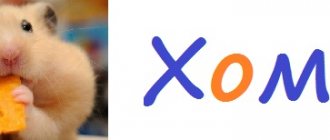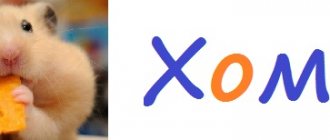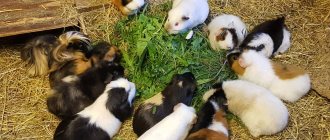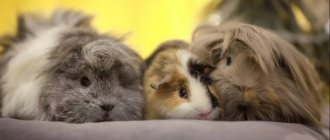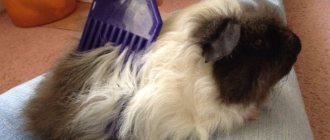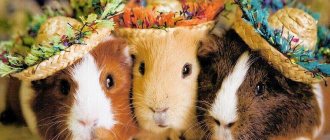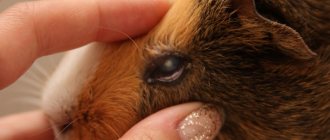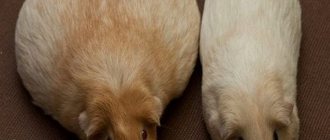Changing a place of residence is always stressful for an animal. Therefore, before purchasing a pet, you need to make sure that he likes it in his new home. The animal’s health, well-being and mood directly depend on how cozy and comfortable the pet will be in its home. In order for a guinea pig to appear, you need to think about where it will live and equip this place with the necessary accessories. These devices can be purchased at animal supply stores or made with your own hands.
Keeping a Guinea Pig
To keep a guinea pig at home you will need:
- Cell;
- Aviary;
- House;
- Filler;
- Drinking bowl;
- Feeders;
- Sennik;
- Toilet;
- Mineral stone.
Cage, aviary
If the cage is small, then it is necessary to additionally install an enclosure for walking. The minimum cage size for keeping one individual is 40 by 60 cm.
The most suitable cage size for a pet is 90 by 120 cm, then the enclosure does not need to be installed.
Which cage to choose, large or small, and additionally add an enclosure? If there are other animals in the house that do not live in a cage, it is dangerous to set up an open enclosure. In this case, you should immediately purchase a large cage, which is suitable for both living and walking.
Guinea pigs are often kept in aquariums or terrariums. Not the most practical option because it requires additional care.
There is poor air circulation in the aquarium, which may result in a lack of oxygen. Also, the aquarium is poorly ventilated and the filler often becomes damp.
Therefore, a cage is considered the best option for keeping rodents.
The height of the cage or enclosure should not be lower than 40 cm. The pet must be able to stand on its hind legs. Also, sufficiently high sides will prevent escape from the cage or enclosure.
The rods of the rodent cage must be iron. They can easily chew through wooden or plastic rods and run away.
Before choosing a cage, check all the parts; they should not be painted. The rodent will probably try to chew the bars. If there are painted parts, he may get poisoned.
Inspect the door carefully. It should close tightly and be strong.
The bottom of the cage should be solid, preferably made of plastic. If the bottom is slatted, the animal will get stuck and damage its paws.
Checkered accessories
What needs to be installed in the cage:
- House;
- Feeder;
- drinking bowl;
- Sennik;
- Toilet;
- Mineral stone;
- Toys.
It is necessary to put a house in the cage so that the guinea pig can rest from excessive attention and feel safe.
The basis of the guinea pig's diet is hay, and she chews it constantly. The feeder is needed for juicy and green food. Since succulent food spoils quickly, the feeder should be washed daily.
Rodents' teeth grow throughout their lives and must be ground down daily. A mineral stone that needs to be fixed to the cell wall is great for this. It will also be useful to add tree branches to your diet.
In order for your guinea pig to maintain an active lifestyle, toys must be placed in the cage. You can also hang a hammock in the cage, install ladders and tunnels.
Special toilet fillers
Not all types of special litter for toilets are suitable for a guinea pig cage. Only cellulose or wood based bedding can be used. Your pet may try to eat the litter, so clumping formulations are not suitable. It is acceptable to use silica gel litter if the pig is not interested in it as a dental trainer or treat. It is recommended to cover such a filler with a PVC mat or other bedding.
Advantages of the filler:
- absorbs moisture well,
- eliminates unpleasant odors,
- easy to clean.
Flaws:
- high cost,
- dangerous if your pet eats it.
Guinea pig care
Guinea pig care includes:
- Cleaning and disinfection;
- Feeding;
- It is necessary to monitor the appearance and health of the pet.
Cleaning
To avoid an unpleasant smell in the cage, you need to clean the cage at least once a week. When cleaning, the animal is moved away so as not to disturb it.
The cage is disinfected once a month. At the same time, the cage, toys, feeders, and drinking bowls are treated. When processing, do not use products with a chemical composition. A strong smell can scare away the animal.
Feeding
Feeding a guinea pig is one of the important points in care and maintenance. If a guinea pig is allowed to starve for 12 hours or more, this can lead to disruption of the internal organs and the death of the animal.
The guinea pig's diet consists of:
- 60% hay;
- 30% juicy and green food;
- 10% granular feed;
- Tree branches;
- Vitamins.
It is important to alternate succulent food. At one time it is necessary to give 2-3 different vegetables or fruits. Change the menu daily. You cannot feed one carrot or one apple all the time.
It is also not recommended to mix fruits and vegetables that do not go together. For example, banana and cabbage. It is better to feed them at different meal times.
There must be water in the cage. It is best to secure the drinking bowl on the wall of the cage, otherwise the animal will turn it over and trample it. Do not use tap water. You can give filtered or bottled water.
Appearance and health
- Fur care. It is important to care for the fur of long-haired guinea pigs on a daily basis. Use a small fur comb and comb out debris and tangles. Short-haired species do not need to be combed.
- Trimming claws. It is important to provide your guinea pig with an active lifestyle. It is necessary to purchase a spacious cage or enclosure for walking. If the rodent does not grind off its claws on its own, they need to be trimmed.
- Ear cleaning.
- Bathing. Washing guinea pigs is not recommended. You can bathe a rodent only if it is dirty and you cannot do without water procedures. After bathing, the guinea pig must be thoroughly dried in a towel, and only then allowed to run around the cage. Under no circumstances should a wet animal be released, otherwise it will catch a cold. You should also not blow-dry your fur.
- Teeth. Since guinea pigs are rodents, it is important to monitor the condition of their teeth. If you feed incorrectly, your teeth will not grind down, which will cause injury to your mouth. Also, from birth the incisors may be incorrectly positioned. It is necessary to check the length of teeth periodically. If they are too long, veterinary assistance will be required.
Main tasks of litter
Guinea pig bedding performs several functions:
- Toilet.
- Place to play.
- To maintain the health of the genitourinary system.
The litter for the toilet should completely absorb the animal's excrement, urine and water. It's no secret that guinea pigs love to play and almost never sit in one place. Therefore, they are often buried in a filler that resembles soil or hay in consistency. In addition, these rodents are highly likely to develop diseases associated with the genitourinary system, the development of fungi and baldness.
IMPORTANT: A pet needs a correctly selected litter not only for convenience, but also to maintain health.
What types of bedding are there?
Recommendations
- Guinea pigs are very shy. You should not talk loudly or shout in their presence. Stress greatly reduces life expectancy.
- It is important to choose the right location for the cage. This should not be a passable place. The cage should not be exposed to sunlight and there should be no drafts. But you shouldn’t place the cage in a deserted place either. Otherwise, the animal will become weaned from humans, and it will be difficult to tame.
- Guinea pigs are very social animals. It is better to keep them in pairs. Moreover, you can have a couple of opposite sexes, or you can have two females. Males can be placed in the same cage if they have lived together since birth. Otherwise, they may fight and injure each other.
- From time to time it is necessary to let the animal out of the cage to run freely. If the rodent has a small cage and does not have an enclosure, this is a must. You can fence off the area yourself to prevent it from escaping.
- The animal must not be allowed to fall. They are easy enough to hold in your hands. If you are picking up a guinea pig for the first time and don’t know what to expect, then it is better to conduct training over a soft surface, for example, over a sofa or chair.
- Guinea pigs can live up to 20 years. It is important to choose a beautiful and sonorous name that will not irritate.
- It is imperative to tame your guinea pig. You need to be patient and practice daily. A tamed animal will not be so timid and can be easily taken out of the cage for cleaning.
In order for a guinea pig to live a long time, it is important to provide it with comfortable living conditions and adhere to the rules for caring for the animal. Particular attention should be paid to feeding, since the activity and life expectancy of a guinea pig primarily depends on it.
Items for entertainment
The guinea pig's body needs to move. The animal quickly develops the territory of the home, and its interest fades over time. In order to motivate your pet to move, it is necessary to equip the house with various toys and replace them regularly.
The comfort zone of an animal of this species is a room, which is similar to a hole. Consequently, tube-shaped objects are popular among rodents. The labyrinth can arouse interest for a long period of time. A high level of activity has a positive effect on the physiological health of gilts and helps prevent obesity.
Aviary for walks
In the warm season, you can build an enclosure on your balcony or dacha for walks in the fresh air, where the animal can at the same time enjoy fresh grass. Basic requirements for the product:
- the enclosure is made of wooden slats and metal mesh;
- the pen is installed on legs, since pigs should not be allowed to be on a wet floor;
- minimum pen dimensions: height - 50 cm, length - 100 cm, width - 50 cm;
- the design should protect pets from other animals.
Bed
Unlike bedding, a bed is not a mandatory attribute in a pet's cage, but a piglet will appreciate a cozy place to sleep. The bed should be spacious enough so that the animal can stretch out its legs if desired. Soft sides are also welcome; the animal can use them as a pillow.
At the pet store you can find beds of various sizes and colors. A comfortable mattress or bag can be easily made with your own hands: sewn or knitted. If the owner sewed the bed herself, taking into account all the features of the pet, then the likelihood that the animal will fall in love with the new sofa is higher.
The most popular are round-shaped beds. To sew such a basket you will need:
- textile,
- padding polyester,
- threads,
- rubber.
Product pattern
In the center there is a sleeping place, and along the edges there are sides. The length of the AB line is the length of the sleeping place, it depends on the size of the pet (it is better not to make it less than 30 cm). The height of the sides should not be too high so that the rodent can easily get into the shelter (no more than 5 cm).
Tips for selection and installation
When selecting and installing a rack structure, certain rules and recommendations should be followed. The design of the pig's home should be combined with the other furnishings of the room and the interior as a whole.
The rack is installed at a distance of at least 5 cm from walls and furniture. It is prohibited to place the structure near heating devices, or under direct sunlight. The lack of light is also not beneficial for pigs, so it needs to be supplemented with artificial lighting (a garland of lanterns, etc.).
The minimum permissible height of the tiers is 30–35 cm, the recommended one is 40–60 cm. As for the area of the home, the larger it is, the better. For a comfortable stay of one animal, a minimum of 50–70 cm² is required, for two pets - at least 90 cm².
If possible, it is worth purchasing for a friend's pet. In nature, guinea pigs do not live alone, so such an existence is unnatural for them. Even if the owner pays the proper amount of attention, the pet still needs to communicate with its relatives.
A rodent living alone eats more and moves less than its relatives living side by side. Therefore, in order for your pet not to get bored, to be cheerful and cheerful, it is worth placing a neighbor with him. If there are a lot of animals, you should prefer a high multi-tiered structure. The design up to the ceiling is easier to fix and saves space in the room.
It is better to allocate the upper tier for the bedroom. It is also recommended to place mini-houses on top for privacy. A feeding trough and drinking bowl must be installed on one of the floors (several are allowed). A pet’s home should not consist only of a sleeping and dining room - it is also necessary to equip a play area.
Cage requirements
Although domestic rodents may seem fat and clumsy at first glance, believe me, they are very fast and sharp. Any guinea pig owner can confirm this - you have to try hard to catch an animal that has run out of its cage. Therefore, the size of the structure where your pet will live is very important, especially if you do not allow him to leave the cage.
In general, you should understand that the larger the structure, the more comfortable it will be for the pet, which is why a terrarium or enclosure with a large enclosure always remains the most popular. If you decide to make an enclosure on your own, then this is even better - you can select all the necessary dimensions yourself in accordance with the photos and drawings provided below. The size should be such that the pet can be carried into the cage without any problems, holding it in your hands. In addition, regardless of size, the structure must be more than durable, since pigs can chew not only thick cardboard, but also wood without any problems. In addition, animal feces are quickly absorbed into the cardboard, as a result of which such a house will become a breeding ground for bacteria and diseases.
The best option would be a cage with a plastic bottom and the ability to dismantle the upper part. Why the bottom should be plastic is understandable, all because pigs often gnaw at the bottom of the cage. Additionally, if you have a dune cage, this way you can easily clean and disinfect your pig’s house. In general, in any case, exclude wood as an option for making the bottom of the cage. At a minimum, the bottom should be plastic for hygienic reasons.
DIY cage construction
Before proceeding directly to construction, you need to make a drawing. If possible, we make a life-size drawing. If this is not possible, then we make a reduced drawing, while maintaining the relationship between all structural elements.
Be sure to display on the resulting diagram all the elements that will be located inside the structure (drinkers, feeders, sleeping houses). After completing the diagram, it will be easy to determine how much free space will remain in the cage, and whether it will be enough for the pet to lead an active lifestyle.
The construction process can be roughly divided into 4 stages.
Stage 1
We draw the base of the cage on corrugated cardboard. It is a rectangle with side walls. The height of the side walls should not exceed 15 cm. The easiest way is to make this structural element one-piece. We draw 2 rectangles on corrugated paper, the walls of one of which should be 30 cm smaller than the other. In this case, their centers (the intersection of the diagonals) must coincide. Then, using a construction knife, we cut through the top layer of corrugated cardboard along the lines that form the inner rectangle.
If you look at the markings of corrugated cardboard, you can see squares with a side of 15 cm in its corners. To make it convenient to fold the sides of the bottom of the structure, we cut through one of the inner sides of the squares completely, and the second - partially (only the top layer).
All that remains is to fold the base, bending it at the places where the top layer of corrugated cardboard is cut, and connect the walls to each other, securing the joints with adhesive tape. The fixation must be reliable. You can additionally use adhesives or a construction stapler.
Stage 2
At this stage we are assembling the walls. Each wall should be assembled separately. It is advisable to use pieces of metal lattice 0.3-0.4 m wide. If, for example, the width of the building is 80 cm, then take 2 sections of 0.4 m each. If the wall length is 1.20 m, take 3 sections of 0.4 m each or 4 sections of 0.3 m each.
